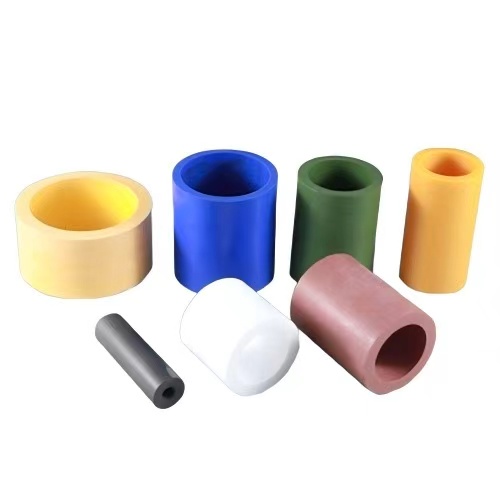
Introduction to Filled PTFE Tubes
Filled PTFE Tubes, fully known as Filled Polytetrafluoroethylene Tubes, are tubular products made by blending PTFE resin with one or more filling materials and forming them through specific processes (typically compression molding or extrusion).
The name directly highlights two core pieces of information:
- Base Material: Polytetrafluoroethylene (PTFE), commonly known as "Teflon" or the "King of Plastics," which provides the foundational properties.
- Modification Method: Filled, meaning other materials are added to mitigate certain shortcomings of pure PTFE.
Why Fill PTFE?
Pure PTFE boasts exceptional chemical stability, an extremely low coefficient of friction, and a broad operating temperature range. However, it also has several significant drawbacks that limit its applications in mechanical fields:
1. Poor Wear Resistance: Soft texture, prone to wear.
2. Prone to Cold Flow (Creep): Subject to plastic deformation under sustained pressure.
3. Low Mechanical Strength: Poor rigidity and insufficient dimensional stability.
4. Poor Thermal Conductivity: Heat dissipation is challenging.
5. High Coefficient of Thermal Expansion: Dimensions change noticeably with temperature fluctuations.
The purpose of fillingis to significantly improve these mechanical and physical shortcomings** by adding other materials while largely retaining PTFE's original excellent chemical and thermal properties.
Common Filling Materials and Their Functions
Different fillers target specific performance enhancements. Common filling materials include:
- Glass Fiber (GF):
- Function: Significantly improves wear resistance, rigidity, and mechanical strength, and suppresses cold flow.
- Characteristics: One of the most commonly used and classic fillers, offering excellent overall performance.
- Graphite, Molybdenum Disulfide (MoS?):
- Function: Further enhances self-lubrication and reduces the coefficient of friction, minimizing wear.
- Characteristics: Suitable for high PV (Pressure × Velocity) applications without oil lubrication.
- Carbon Fiber (CF):
- Function: Improves wear resistance, strength, and rigidity while significantly enhancing thermal conductivity and dimensional stability.
- Characteristics: Performs better than glass fiber but at a higher cost.
- Bronze:
- Function: Greatly improves thermal conductivity, compressive strength, and wear resistance.
- Characteristics: Ideal for bearing materials in heavy-duty applications with high heat dissipation requirements.
- Polyimide (PI):
- Function: Enhances wear resistance and resistance to compression deformation.
Composite filling sare also commonly used, such as 15% glass fiber + 5% graphite, to achieve multiple enhancement effects simultaneously.
Key Characteristics and Advantages
Filled PTFE tubes combine the dual advantages of PTFE and fillers:
1. Exceptional Wear Resistance: Wear resistance can be hundreds to thousands of times better than pure PTFE.
2. Excellent Mechanical Properties: Higher compressive strength, rigidity, and creep resistance (anti-cold flow).
3. Retained Good Chemical Stability: Still resistant to most chemicals (though tolerance to certain strong acids and alkalis may be slightly reduced compared to pure PTFE).
4. Broad Temperature Range: Generally operable from **-180°C to +250°C**.
5. Good Self-Lubrication: Low coefficient of friction, capable of operating without oil.
6. Improved Dimensional Stability: Reduced coefficient of thermal expansion, minimizing dimensional changes with temperature fluctuations.
Main Application Areas
Filled PTFE tubes are primarily used in applications requiring wear resistance, pressure handling, and dimensional stability, commonly found in:
- Chemical Industry:
- Pipes and liners for transporting corrosive media containing solid particles, crystals, or powders, such as slurries, acids, alkalis, and polymer particles.
- Mechanical Engineering:
- Hydraulic and Pneumatic Systems: Used as sealing tubes, guide rings, and support rings resistant to high pressure and wear.
- Oil-Free Lubrication Bearings: Manufacturing bearing sleeves and bushings, particularly in corrosive environments or where lubricating oil cannot be used.
- Semiconductor Industry:
- Transporting abrasive high-purity chemicals (e.g., CMP slurry).
- Food and Pharmaceutical Industries:
- Wear-resistant transport pipelines requiring high-temperature sterilization (must use food-grade compliant fillers such as graphite or glass fiber).
Comparison with Pure PTFE Tubes
| Property |
Pure PTFE Tubes |
Filled PTFE Tubes |
| Wear Resistance |
Poor |
Excellent |
| Creep Resistance |
Poor |
Excellent |
| Mechanical Strength |
Low |
High |
| Thermal Conductivity |
Poor |
Improved |
| Chemical Inertness |
Exceptional |
Good (may be slightly reduced) |
| Primary Applications |
Corrosion resistance, insulation, non-stick |
Wear resistance, pressure handling, mechanical components |
Filled PTFE Tubes are the product of high-performance modification of pure PTFE.
- Core Value: They significantly mitigate the critical weaknesses of pure PTFE in mechanical performance (poor wear resistance and susceptibility to deformation), enabling applications in harsh environments subject to friction, pressure, and complex mechanical loads, while largely retaining PTFE's corrosion and temperature resistance.
- Key Selection Factor: The appropriate filler type and proportion must be selected based on specific working conditions (e.g., medium, pressure, speed, temperature, type of wear) to achieve optimal performance and service life.



